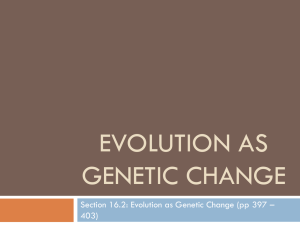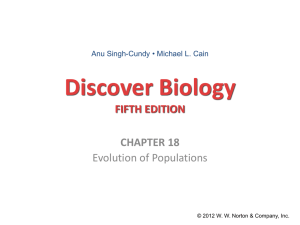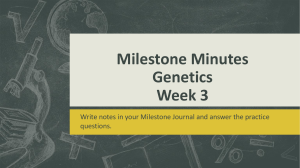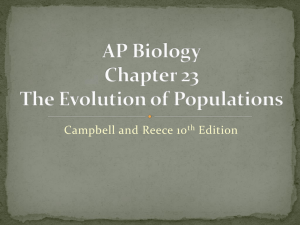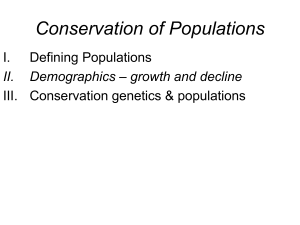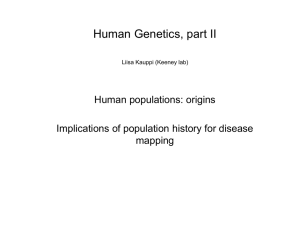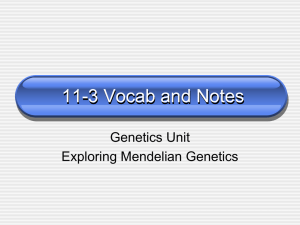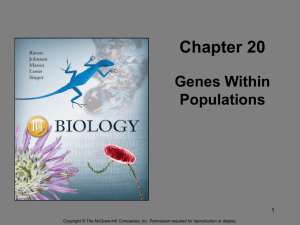Chapter 13
advertisement
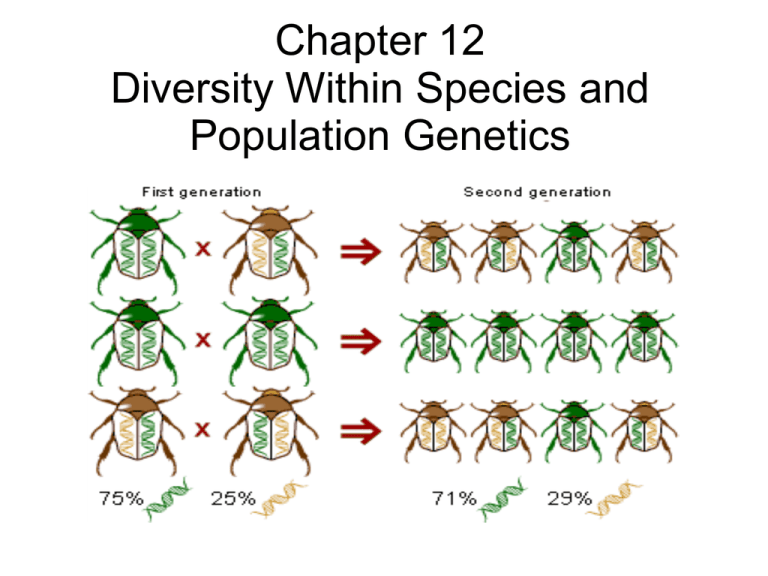
Chapter 12 Diversity Within Species and Population Genetics Mendelian vs. Population Genetics Mendelian genetics describes the inheritance and interaction of alleles in individuals. Example: Each individual has two of the three possible blood type alleles found in humans Population Genetics investigates the kinds and relative abundance of alleles within a population and changes in alleles over time. Terminology A population is a group of organisms that are potentially capable of breeding naturally and are found in a specified area at the same time. All of the beef cattle in Lewis County today. A species consists of all organisms potentially capable of breeding naturally among themselves and having offspring that also interbreed successfully. All of the beef cattle in the world today. Gene Pool A gene pool consists of all the alleles of all the individuals of a population. While any individual may possess only two alleles, a population may many alleles for the same gene. Gene Pool In this “population”, there are 64 possible alleles for blood type (32 individuals, each with 2 alleles). 25 copies of Type A 21 copies of the B allele 40.3% 33.9% 16 copies of the O allele 25.8% Allele Frequency Allele Frequency is how often an allele is found in a population. The allele frequency can differ from population to population. We can see an example with these mice. Some populations have unique alleles. Allele Frequency Different physical characteristics are displayed by people from different parts of the world. In Europe In Africa High allele frequency for light skin, straight hair, and a narrow nose. High allele frequency for dark skin, curly hair, and flat nose In Asia Moderately colored skin, straight hair and broad noses Blood Type Frequency While the B alleles is the rarest blood allele (16%), it is far more common in Central Asia and very low in North America among native populations. Overall 21% of humans have an A allele. It is very common among Blackfoot Indians, Australian natives, and Saami of Northern Scandinavia. Subspecies • Subspecies are populations of individuals who share similar phenotypes (and genotypes) which are different from other populations with different phenotypes (and genotypes). • The northern, Lake Erie, and midland water snakes are subspecies of Nerodia sepidon. • The Lake Erie populations (on islands in the lake) lack lighter patches found in the mainland northern water snake populations. Genetic Diversity • Genetic Diversity describes differences among members of a population. – High genetic diversity indicates many different kind of alleles for each characteristic. – Low genetic diversity indicates that nearly all the individuals in the population have the same alleles. – Mutations – Sexual Reproduction – Migration – Population size Genetically Distinct Populations • There are four reasons for genetically distinct populations – Adaptions to local environmental conditions – Founder Effect – Genetic Bottleneck – Barrier to movement Genetically Distinct Populations • Adaptions to Local Environmental Conditions – In local populations, certain adaptions are valuable for survival in the local environment • • • In the White Sands National Monument in NM, has white gypsum sand, so many of the lizards and mice are light colored There are blind fish in waters where sunlight doesn't reach. Humans have appendixes, that at one time might have been used for everyday use Genetically Distinct Populations • The founder effect is the concept that small, newly established populations are likely to have reduced genetic diversity because of the small number of individuals in the founding populations – Example: Evolution of organisms on volcanic islands – Galapagos Islands were probably derived from one or few initial founders Genetic Bottleneck • Genetic Bottleneck is when there is a sharp reduction in population size due to a chance event, that results in a reduction in genetic diversity in subsequent generations. – All living cheetahs are practically identical genetically – Overhunting reduced the population of northern elephant seals to as few as 20 individuals at the end of 19th century. The population is now over 30,000 but they have far, far less genetic variation than southern elephant seals which were not hunted as severely. Barriers to Movement • With the presence of barriers to free movement, plants and animals are divided into small, separate populations – Plants and animals that live in lakes are going to be divided by land • This would lead to different allele frequencies from lake to lake Genetic Diversity in Domesticated Plants and Animals • In order to create more ideal products, scientists artificially construct specific genetic combinations that are useful or more desirable. – Rapid growth, resistance to disease, etc. • Cloning is the process of reproducing organisms asexually, to create several genetically identical individuals. – Plants are cloned to create a larger food supply Selective Breeding • • In order to preserve desirable traits from certain plants or animals, the mating of individual organisms are controlled. – Intraspecific hybrids are produced by controlled breeding within the same species. – Interspecific hybrids hybrids between two species Beefalo is an interspecific hybrid between cattle and bison. Genetic Engineering & Monoculture • Genetic engineering is to manipulate particular pieces of DNA and transfer them into a specific host. • Monoculture is a kind of agriculture in which large areas are exclusively planted with a single crop with a very specific genetic makeup – Makes it easier to manage crops, but are susceptible to disease due to reduced genetic diversity Human Population Genetics • Even though human populations are not as isolated from one another as they were before easy travel, many people still tend to have children with those who are similar in race, economic background, and socially. – Non-random mating (at an extreme, inbreeding over many generations) can elevate the frequency of otherwise rare alleles. Tay-Sachs Disease • Tay-Sachs disease is a homozygous recessive disease in which some fatty acids are not metabolized and accumulate in nerve cells in the brain. This leads to deterioration of mental and physical abilities until death occurs before age 3. • One form of the Tay-Sachs allele is especially common in Ashkenazi Jews, including U.S. Jews who emigrated from eastern Europe. Fig. 12.13, pg. 253 Eugenics • Eugenics are attempts to apply genetic knowledge directly for the improvement of human existence. – Greek root meaning, “well-born” • Positive Eugenics encourage the breeding of positive characteristics – Superior Intelligence, Artistic Talent • Negative Eugenics are the attempt to restrict the reproduction of parents displaying unfavorable characteristics – Low intelligence, mental retardation and criminal behavior Eugenics in the US • In the early 1900’s in the US, there was a eugenics movement to require sterilization of those considered “genetically inferior” – Over half the states passed laws requiring the sterilization of “imbeciles, idiots, convicted rapists, and habitual criminals”* – By 1931, the law applied to include, “sexual perverts, drug fiends, drunkards, and eqileptics”* – Today, there are still groups and individuals who still believe in getting rid in “bad genes” *The sterilization of Carrie Buck by J.D. Smith and K.R. Nelson Eugenics in WWII • In Nazi Germany during the 1930’s the concept of achieving a superior, racially pure group – Said to have been modeled after the US sterilization programs – First included those considered socially and physically defected – Then expanded to include entire ethnic groups, including Jews and Gypsies – Ended in the mass murder of the Holocaust
